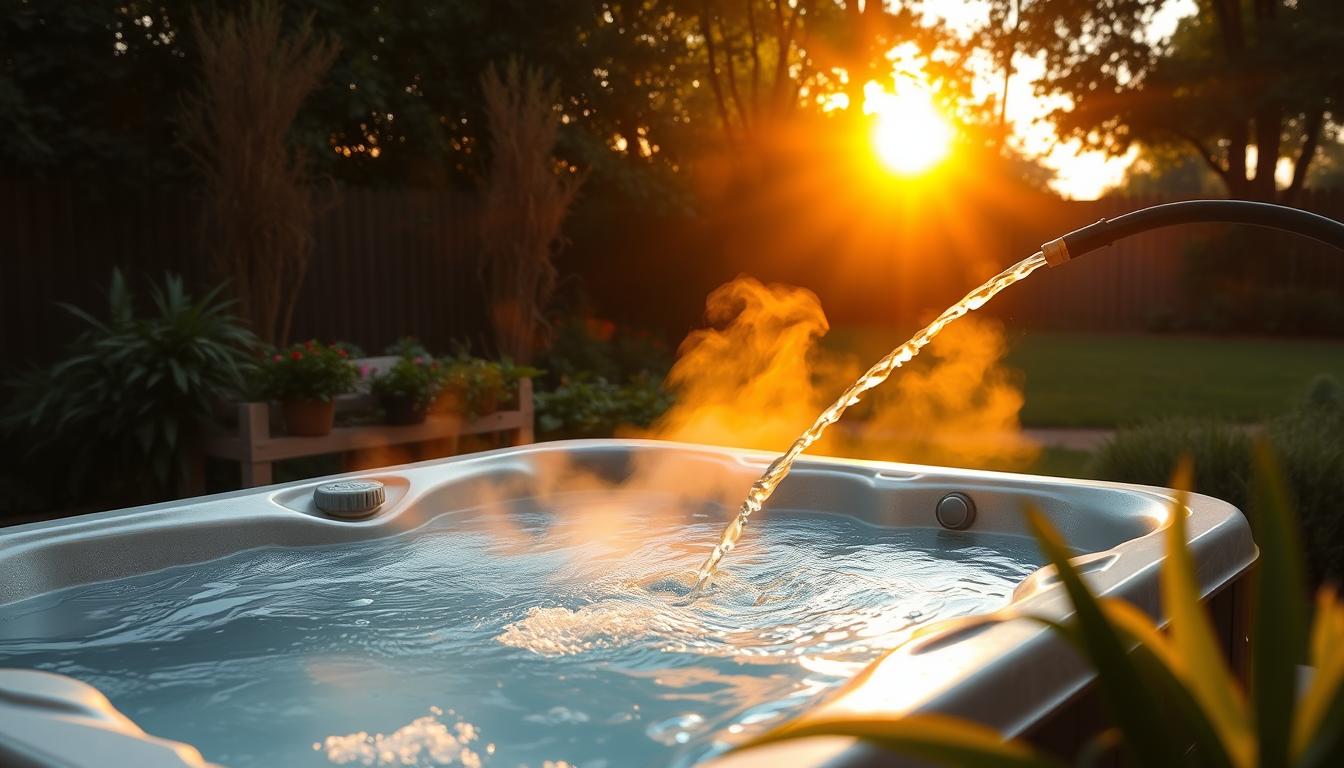
Filling a hot tub is an exciting step towards relaxation. The prospect of soaking in warm, bubbling water is enticing. But first, we need to fill the tub.
Filling your hot tub is crucial for setup and maintenance. It usually takes 30 to 90 minutes, depending on size and water pressure. This process applies to both new installations and routine refills.
The filling process is a milestone in hot tub ownership. It marks the beginning of countless relaxing moments. Let’s explore the filling time, water capacity, and requirements for a smooth experience.
Preparing to Fill Your Hot Tub: Essential Considerations
Proper preparation is key to a smooth hot tub filling experience. It helps prevent equipment damage and ensures comfortable water chemistry. These essential tips will guide you towards a relaxing soak.
Ensuring Water Quality: Testing for Metals and Hardness
Water quality is crucial when filling your hot tub. Test your water source for metals like copper, iron, and manganese. Also, check the calcium hardness level.
High metal levels can stain your hot tub’s shell and components. Excessive calcium hardness may cause scale buildup and reduce plumbing efficiency.
Using a Pre-filter to Correct Alkalinity and pH Issues
A pre-filter can address alkalinity or pH issues before water enters your hot tub. It removes impurities and balances water chemistry, reducing later adjustments.
This step is particularly important for well water. Well water often has more variable chemistry compared to municipal sources.
Adding Enzyme-Based Formulations to Reduce Chemical Need
Consider adding enzyme-based formulations to your fresh hot tub water. These break down organic contaminants like body oils, lotions, and debris.
Enzymes reduce the need for harsh chemicals. This approach is environmentally-friendly and gentler on your skin and eyes.
Follow the manufacturer’s instructions for proper dosing based on your hot tub’s volume.
| Water Quality Factor | Ideal Range | Potential Issues |
|---|---|---|
| pH | 7.2 – 7.8 | Discomfort, equipment damage |
| Total Alkalinity | 80 – 120 ppm | Difficulty maintaining pH balance |
| Calcium Hardness | 150 – 250 ppm | Scale buildup, reduced efficiency |
| Metals (Cu, Fe, Mn) | Minimal to none | Staining, discoloration |
Following these tips will prepare you for a high-quality hot tub experience. You’ll ensure safe, comfortable soaking for you and your loved ones.
Remember, good preparation enhances your hot tub’s longevity and performance. It’s worth the effort for a better soaking experience.
Step-by-Step Guide to Draining and Refilling Your Hot Tub
A clean hot tub ensures a safe and fun soaking experience. This guide will help you drain, clean, and refill your hot tub. Follow these steps to keep your hot tub in great shape.
Adding Plumbing Cleaner and Running the Spa
Pour a full bottle of plumbing cleaner into your hot tub. Run the spa for one hour to circulate the cleaner. Let it sit for 23 more hours.
This step removes buildup in the hot tub plumbing. It ensures proper water flow and prevents future problems.
Turning Off Power Supply and Draining the Tub
Turn off the power supply to your hot tub. Find the spa drain valve and attach a garden hose. Drain the water completely.
Use a shop vac or submersible pump to remove leftover water. About 30% of hot tub owners use submersible pumps for faster draining.
The fastest method combines the drain valve and a sump pump. This can empty the hot tub in less than 30 minutes.
Cleaning the Tub and Refilling with Fresh Water
Close the drain valve and wipe the tub clean. Place a garden hose in the filter area to prevent air bubbles.
Fill the tub until water covers the highest jet. Consider using a hose filter to reduce impurities like calcium and copper.
Follow city rules when draining a hot tub. This prevents environmental damage and ensures you obey the law.
Turning On Power and Adjusting Temperature
Switch the power back on and set your desired temperature. Close the cover to help the water heat faster.
Let the hot tub heat for at least five hours. Then test the water chemistry. Clean your hot tub cover regularly to prevent damage.
Use high-quality covers with strong vinyl exteriors. A cover lifter can reduce strain and make your cover last longer.
Testing and Balancing Water Chemistry
Check the water’s pH, alkalinity, and sanitizer levels with test strips. Adjust levels as needed for safe soaking.
Test and adjust water chemistry monthly. Drain and refill your hot tub every three to four months.
Regular maintenance prevents biofilm buildup. Follow these tips to enjoy your hot tub for years to come.







